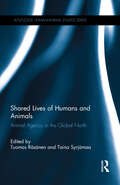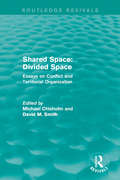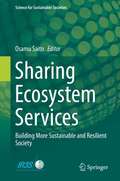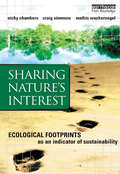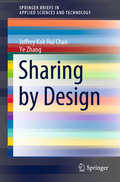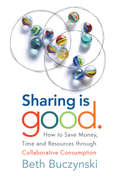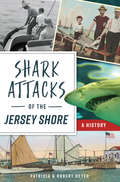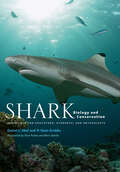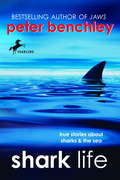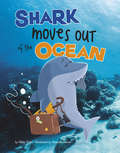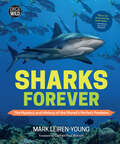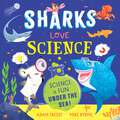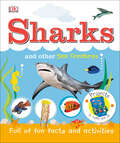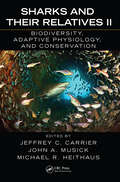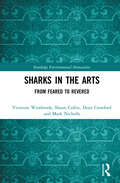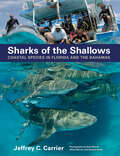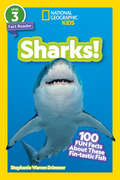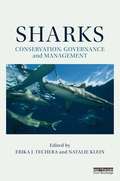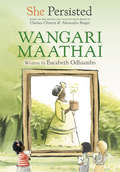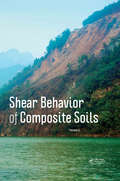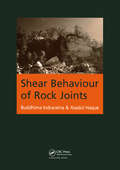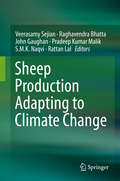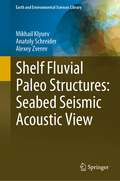- Table View
- List View
Shared Lives of Humans and Animals: Animal Agency in the Global North (Routledge Human-Animal Studies Series)
by Tuomas Räsänen Taina SyrjämaaAnimals are conscious beings that form their own perspective regarding the lifeworlds in which they exist, and according to which they act in relation to their species and other animals. In recent decades a thorough transformation in societal research has taken place, as many groups that were previously perceived as being passive or subjugated objects have become active subjects. This fundamental reassessment, first promoted by feminist and radical studies, has subsequently been followed by spatial and material turns that have brought non-human agency to the fore. In human–animal relations, despite a power imbalance, animals are not mere objects but act as agents. They shape our material world and our encounters with them influence the way we think about the world and ourselves. This book focuses on animal agency and interactions between humans and animals. It explores the reciprocity of human–animal relations and the capacity of animals to act and shape human societies. The chapters draw on examples from the Global North to explore how human life in modernity has been and is shaped by the sentience, autonomy, and physicality of various animals, particularly in landscapes where communities and wild animals exist in close proximity. It offers a timely contribution to animal studies, environmental geography, environmental history, and social science and humanities studies of the environment more broadly.
Shared Space: Essays on Conflict and Territorial Organization (Routledge Revivals)
by David M. Smith Michael ChisholmThis specially commissioned volume of original essays, first published in 1990, provides a unique view of conflict, territorial behaviour and reconciliation between groups – social, racial, religious and nationalist – within states in both the developed and the developing worlds. The volume as a whole shows the wide range of geographical solutions which have been adopted in attempts to limit conflict and foster stability. This title underlines the importance of a geographical perspective on intergroup conflict and reconciliation, and provides a broad range of real-world experience in carefully chosen case studies. Shared Space: Divided Space will be of interest students of the social sciences as well as to general readers, who will find this title to be accessible and authoritative.
Sharing Ecosystem Services: Building More Sustainable and Resilient Society (Science for Sustainable Societies)
by Osamu SaitoUsing “the sharing paradigm” as a guiding concept, this book demonstrates that “sharing” has much greater potential to make rural society resilient, sustainable and inclusive through enriching all four sharing dimensions: informal, mediated, communal and commercial sharing. The chapters are divided into two parts, one that focuses on case studies of the sharing ecosystem services in Japan, the other on case studies from around the world including in the regions of Africa, Asia-Pacific, South America and Europe. Reflecting the recent growing attention to sharing concept and its application to economic and urban context, this publication explores opportunities and challenges to build more resilient and sustainable society in harmony with nature by critical examination of sharing practices in rural landscapes and seascapes around the world. This book introduces not only traditional communal and non-market sharing practices in different rural areas, but also new forms of sharing through integration of traditional practices and modern science and technologies.
Sharing Eden
by Natan Levy David Shreeve Harfiyah Haleem"Finding common ground between Christianity, Islam, and Judaism is a critical priority for the whole world-and nowhere is that common ground more evident or inspiring than on environmental issues."- Jonathon Porritt, co-founder, Forum for the Future"[A] very encouraging and helpful project, and I hope it inspires those in each of the three traditions to collaborate more in environmental thought."-Sustainability in Crisis, United KingdomThis introductory handbook combines beautiful and enlightening texts from each faith's religious teachings to address some of the most prominent environmental issues faced today, such as waste, climate change, and biodiversity. Each author brings a contemporary focus to the eternal challenge of caring for the environment and provides practical advice on how we can all do our share to protect it.Sharing Eden sets out to show how respect for the environment is at the heart of Judaism, Christianity, and Islam.Natan Levy is the environmental liaison for the Chief Rabbi's Office and the rabbinical expert for the London School of Jewish Studies' Responsibility Unit, both based in the Untied Kingdom.David Shreeve is the director of The Conservation Foundation, which he co-founded in 1982, and the environmental advisor to the Archbishops' Council of the Church of England.Harfiyah Haleem is a trustee of the Islamic Foundation for Ecology and Environmental Sciences (IFEES). She is also the editor of a collection of essays on Islam and the environment and co-editor of the Muslim Green Guide to Reducing Climate Change.
Sharing Nature's Interest: Ecological Footprints as an Indicator of Sustainability
by Nicky Chambers Craig Simmons Mathis WackernagelEcological footprinting is rapidly being adopted as an effective and practical way to measure our impact on the environment - in both large- and small-scale planning and development. This is an introduction to ecological footprint analysis, showing how it can be done, and how to measure the footprints of activities, lifestyles, organizations and regions. Case studies illustrate its effectiveness at national, organizational, individual and product levels.
Sharing by Design (SpringerBriefs in Applied Sciences and Technology)
by Jeffrey Kok Chan Ye ZhangThis book answers the question of how to design a sharing system that can promote sustained, meaningful, and socially constructive sharing practices in today’s cities. To do so, it constructs a framework for practical inquiry into the design of sharing systems. Further, the book invites readers to consider questions such as: If sharing can be designed, then how does one design a sharing system for cities? Which urban conditions make this sharing system possible? What are the considerations, variables, and methods that can inform and guide the designers of a sharing system? By considering both the environmental and societal motivations for sharing, and the reality that most examples of the Sharing Economy are neither equitable in their socio-economic outcomes nor genuine in their original social promises, this book presents balanced and thoughtful answers to the questions posed above. The book will appeal to a broad readership, from students and teachers in the various design disciplines, to professionals and scholars in architecture and urbanism, business and innovation, and other related fields of the humanities and social sciences, as well as activists and policymakers committed to achieving more sustainable and equitably distributed access to urban resources.
Sharing is Good
by Beth BuczynskiCollaborative consumption is a new way of living in which access is valued above ownership, experience is prized over material possessions, and "mine" becomes "ours," allowing everyone's needs to be met with minimum waste. Bursting at the seams with hundreds of helpful tips and valuable resources, Sharing is Good is a practical guide to this new and exciting "sharing economy."
Shark Attacks of the Jersey Shore: A History (Disaster)
by Robert Heyer Patricia HeyerEvery summer, thousands flock to the Jersey Shore for its beaches and boardwalks, but lurking in the depths beyond is a historic threat to tranquility. Dozens of shark attacks and interactions have occurred throughout Jersey Shore history that reveal bravery, heartbreak and the hubris of man. A boy paid a gruesome price for teasing a trapped shark in the first recorded attack in 1842. The three bloody attacks of 1960 left one man's limb amputated. The horrific summer of 1916 included seven attacks in a two-week span and crafted the caricature of the killer shark that remains in popular culture today. Authors Patricia and Robert Heyer dive into the history of when two apex predators, man and shark, cross paths on the shores of New Jersey.
Shark Biology and Conservation: Essentials for Educators, Students, and Enthusiasts
by Daniel C. Abel R. Dean GrubbsFeed your fascination with sharks! This complete resource enlightens readers on the biology, ecology, and behavior of sharks with approachable explanations and more than 250 stunning color illustrations.Studies of shark biology have flourished over the last several decades. An explosion of new research methods is leading to a fascinating era of oceanic discovery. Shark Biology and Conservation is an up-to-date, comprehensive overview of the diversity, evolution, ecology, behavior, physiology, anatomy, and conservation of sharks. Written in a style that is detailed but not intimidating by world-renowned shark specialists Dan Abel and Dean Grubbs, it relays numerous stories and insights from their exciting experiences in the field. While explaining scientific concepts in terms that non-specialists and students can understand, Abel and Grubbs reveal secrets that will illuminate even the experts. The text provides readers with a robust and wide range of essential knowledge as it• introduces emerging as well as traditional techniques for classifying sharks, understanding their behavior, and unraveling the mysteries of their evolution;• draws on both established shark science and the latest breakthroughs in the field, from molecular approaches to tracking technologies;• highlights the often-neglected yet fascinating subject of shark physiology, including heart function, sensory biology, digestion, metabolic performance, and reproduction;• addresses big picture ecological questions like "Which habitats do sharks prefer?" and "Where do sharks migrate and for what purpose?";• describes the astonishing diversity of sharks' adaptations to their environment;• discusses which shark conservation techniques do and don't work; and• comments on the use and misuse of science in the study of sharks.Enhanced by hundreds of original color photographs and beautifully detailed line drawings, Shark Biology and Conservation will appeal to anyone who is spellbound by this wondrous, ecologically important, and threatened group, including marine biologists, wildlife educators, students, and shark enthusiasts.
Shark Life
by Peter BenchleyIn this riveting true adventure and informative guide to the sea, master storyteller Peter Benchley draws on more than four decades of diving experience to bring us face to face with the array of sharks and other marine animals he and his family have encountered, almost always on purpose--but sometimes by accident. In direct and accessible prose, Peter sets the record straight about the many types of sharks (including the ones that pose a genuine threat to us), the behavior of sharks and other sea creatures we fear, the odds against an attack, and how to improve them even further. He also teaches us how to swim safely in the ocean by reading the tides and currents and respecting all the inhabitants. Here are the lessons Peter has learned, the mistakes he has made, the danger he has faced--and the spectacular sights he has seen in the world's largest environment. The book includes 16 pages of black-and-white photographs. "From the Hardcover edition. "
Shark Moves Out of the Ocean (Habitat Hunter)
by Nikki PottsShark is bored with its habitat! Follow Shark as it tries out different places to live. Which habitat will make the best home for Shark?
Sharkovsky Ordering (SpringerBriefs in Mathematics)
by Alexander M. Blokh Oleksandr M. SharkovskyThis book provides a comprehensive survey of the Sharkovsky ordering, its different aspects and its role in dynamical systems theory and applications. It addresses the coexistence of cycles for continuous interval maps and one-dimensional spaces, combinatorial dynamics on the interval and multidimensional dynamical systems. Also featured is a short chapter of personal remarks by O.M. Sharkovsky on the history of the Sharkovsky ordering, the discovery of which almost 60 years ago led to the inception of combinatorial dynamics. Now one of cornerstones of dynamics, bifurcation theory and chaos theory, the Sharkovsky ordering is an important tool for the investigation of dynamical processes in nature. Assuming only a basic mathematical background, the book will appeal to students, researchers and anyone who is interested in the subject.
Sharks Forever: The Mystery and History of the Planet’s Perfect Predator (Orca Wild #9)
by Mark Leiren-YoungExplore the latest science about sharks. Did you know that some sharks have friends? Or that there are sharks small enough to swim in a soup can? There are sharks who can walk on land and others who make their own light. There are ancient sharks who lived in the oceans millions of years ago, and new species who have just been discovered. Most importantly, did you know that most sharks are fighting for their survival? Sharks Forever takes a deep dive into the lives of sharks––their habitat, biology, habits and personalities. It also looks at the biggest threats to their existence, from marine pollution and overfishing to bycatch and shark-fin soup. It goes beyond the bites and shares stories about people who swim with sharks and call them friends.
Sharks Love Science: Science is fun under the sea!
by Adam FrostIntroduce young readers to science through an amazing underwater world!Packed with sea-life facts and awe-inspiring science, Sharks Love Science looks at animal families, wild weather at sea, ocean habitats, types of sharks - from the great white to the frilled - and so much more. And guess what? Science is SUPER fun. Try this for shark-loving size...Which ocean animal looks like it has escaped from a toolbox? (It's the hammerhead shark, of course!)Can you find the scary-sounding creatures lurking in the ocean's midnight zone? (Look out for the goblin shark and the vampire squid - eek!)How often do penguins poo? (Every 20 minutes - that's more than any other animal!)The perfect picture book for shark-loving kids and all the kids who just want to know HOW and WHY, Sharks Love Science has hilarious illustrations and is packed with super-cool marine animals to make science fun for children aged 5+. Also includes two simple science experiments for budding scientists to try.This second book in the series follows on from Dinos Love Numbers - a wacky, dinosaur-packed introduction to maths for younger readers,
Sharks and Other Sea Creatures (Projects to Make and Do)
by DKPacked with fun activities, crafts, reading games, and amazing facts, kids can take a dive under the waves and meet all the colorful creatures beneath—from clown fish to starfish to jellyfish—in this educational project book.In Sharks and Other Sea Creatures, each page has engaging photographs with clear text and simple step-by-step instructions for young readers to follow as they complete each project. Kids can learn how to create an egg carton ocean, make pretty paper plate clown fish, and make their way through an octopus maze. Perfect for kids who love the enchanting creatures of the deep, this book will improve their dexterity, memory, and brain development with each activity.Keep kids entertained as they learn with Sharks and Other Sea Creatures.Series Overview: Created especially for kids ages 3–5, DK's Practical Facts series blends gentle educational content with simple practical activities such as crafts, cooking, and counting, providing young readers with a broad reading experience in which they learn by doing. The simple activities reinforce the fun facts and aid in the development of literacy, numeracy, memory, and dexterity. Keep kids entertained as they learn with DK's Practical Facts series.
Sharks and Their Relatives II: Biodiversity, Adaptive Physiology, and Conservation (CRC Marine Biology Series)
by Michael R. Heithaus Jeffrey C. Carrier John A. MusickSince the award-winning first volume, The Biology of Sharks and Their Relatives, published in 2004, the field has witnessed tremendous developments in research, rapid advances in technology, and the emergence of new investigators beginning to explore issues of biodiversity, distribution, physiology, and ecology in ways that eluded more traditional
Sharks in the Arts: From Feared to Revered (Routledge Environmental Humanities)
by Dean Crawford Mark Nicholls Vivienne Westbrook Shaun CollinThis book is the most thorough exploration to date of the many ways in which a wild creature has been absorbed, reimagined and represented across the ages in all of the major art forms. The authors consider not only how the identity of sharks in the natural environment became incorporated into a cultural environment but also how sharks came to be considered the most feared creatures in the open oceans as a consequence of this incorporation. Yet sharks are especially important in helping to maintain a balance that is essential to the health of the oceans. The book begins with a treatment of the three sharks at the top of global shark-attack files from scientific, economic and environmental perspectives. Subsequent chapters engage with cultural representations of sharks in poetry, drama, art, novels, screenplay adaptations and films. Through an exploration of the ways in which sharks have been represented in human culture through the centuries, this book alerts the global community to the importance of sharks as a common cultural heritage. It aims to change perceptions of sharks so that they can become more revered than feared. The authors of this book argue that an increased understanding of sharks should lead to the development of better strategies for shark and human interactions. This book will be of great interest to researchers and students of the Environmental Humanities, Cultural History and the Arts. It is also excellent supplementary reading for courses in Zoology and Marine Science.
Sharks of the Shallows: Coastal Species in Florida and the Bahamas
by Jeffrey C. CarrierThrilling underwater photographs enrich this unique guide to the shallow-water sharks of Florida and the Bahamas.Agile, sleek, and precise, sharks display many qualities we can admire and appreciate. These marvels of evolution have adapted to thrive in every major aquatic realm on the planet, from frigid Arctic waters through temperate but stormy seas and on into the tropics. However, few places on Earth are home to the amazing diversity of shark species that beautify the shallow waters of Florida and the Bahamas. In this first-ever book dedicated to the sharks of this region, biologist Jeffrey C. Carrier reveals the captivating lives of these large marine predators and describes how they have survived for over 400 million years. Guiding readers through basic biology, key attributes, and identification tips, the book explores what makes sharks such successful apex predators. Carrier explains fascinating phenomena, including the reason for the bizarre shape of the hammerhead, how a bull shark is able to swim hundreds of miles up freshwater rivers, what lies behind sharks’ remarkable capability to learn and remember, and why many scientists believe that they are equipped with the most sophisticated sensory systems in the animal kingdom.With the stunning full-color underwater photography of Andy Murch, Jillian Morris, and Duncan Brake, Sharks of the Shallows brings boaters, fishers, divers, and shark lovers directly alongside these unfairly maligned creatures. And not a moment too soon! Sharks are experiencing stresses unlike any in their long history, and are struggling to survive in a changing ocean. They will continue to grace our coastlines only if we care enough to understand them.
Sharks!: 100 FUN Facts About These Fin-tastic Fish (National Geographic Readers)
by Stephanie Warren DrimmerSharp teeth and pointy fins—look out! It’s a shark! Learn all about these fascinating predators in this jam-packed Level 2 Fact Reader from National Geographic Kids, now with more than 200 books in the series from Pre-reader to Level 2 in the series. From great whites and sawfish to hammerheads and tasseled wobbegongs, sharks rule Earth’s oceans. Discover all about their incredible hunting skills, amazing teeth, awesome adaptations, and more in this accessible collection of 100 weird-but-true facts and engaging text. Learn about angel sharks that can kill prey in one-tenth of a second, Greenland sharks that can live for more than 400 years, lantern sharks that glow in the dark, and more wild stuff about one of the world’s most feared, fascinating, and vital-to-the eocosystem’s creatures. National Geographic Readers' exciting approach to reading, featuring expert-vetted text and fascinating images, has proved to be a winning formula with kids, parents, and educators. Each reader is written by a talented children's book author and includes a photo glossary and interactive features that reinforce what kids have learned in the book. National Geographic Readers feature engaging text carefully vetted by expert educators and accompanied by magnificent National Geographic photography. Level 2 books feature more challenging text to help readers build their confidence, skills, and vocabulary.
Sharks: Conservation, Governance And Management (Earthscan Oceans #24)
by Natalie Klein Erika J. TecheraThe key aim of this book is to explore the global conservation and management of sharks. There has been a rapid decline in populations of many shark species, while new science has emerged of the critical role they play in marine ecosystems. However, the authors show that conservation law and policy have been slow to develop, with only a small number of iconic species being protected worldwide. The increase in fishing impact – primarily through shark finning and by-catch - has led to shark conservation receiving greater international attention in recent years. The book explores our current knowledge and status of the law and science in relation to sharks with a particular focus on improving frameworks for their conservation and management. Recent trends are analysed, including shark finning bans that have been put in place in several countries, the widening number of nations establishing shark sanctuaries and the growth of shark-based tourism. The efficacy of current listing processes for endangered species and fisheries regulations is also examined. Tourism is explored as an alternative to fishing and the risks and impacts associated with this industry are analysed. Contributors include leading authorities from universities and conservation organizations in North America, Europe and Australia. A common theme is to emphasise the importance of collaborative governance between various interest groups and the need for inter-disciplinary research and management approaches that are necessary to address the decline in sharks.
She Persisted: Wangari Maathai (She Persisted)
by Chelsea Clinton Eucabeth OdhiamboInspired by the #1 New York Times bestseller She Persisted by Chelsea Clinton and Alexandra Boiger comes a chapter book series about women who spoke up and rose up against the odds--including Wangari Maathai!In this chapter book biography by critically acclaimed author Eucabeth Odhiambo, readers learn about the amazing life of Wangari Maathai--and how she persisted. When Wangari Maathai learned about how many trees had been cut down in Kenya, where she was from, she was horrified. So she founded the Green Belt Movement and got friends, family, and even strangers to help her plant trees and respect the environment--and she received a Nobel Peace Prize for her work.Complete with an introduction from Chelsea Clinton, black-and-white illustrations throughout, and a list of ways that readers can follow in Wangari Maathai's footsteps and make a difference! And don&’t miss out on the rest of the books in the She Persisted series, featuring so many more women who persisted!
Shear Behavior of Composite Soils
by Yanrong LiThis book has the purpose of developing an understanding of the factors determining and influencing the shear behavior of soils, with emphasis on composite soils, as they are the most encountered materials in geological and geotechnical engineering in mountainous areas. This objective is reached by examining the soil compressibility, structure of shear zone and its evolution, and water content of shear zone and shear mode of soils together with analyses of the influences of intrinsic properties, e.g. Atterberg limits, particle size distribution, particle shape, and testing conditions, e.g. normal stress and shearing rate. An in-depth review is presented in an approximately chronological order and covers almost all the factors that are believed to influence the mechanical behavior of soils. The equipment and test techniques for shear strength of soils are detailed. The residual shear behavior of composite soil is investigated by means of a systematic laboratory testing program using a large ring shear apparatus and an intermediate direct shear box. The Fast Fourier Transform is employed for the first time to analyze the fluctuations of measured shearstress and discovers the close relationships with both intrinsic properties of soils and testing conditions. Although the book is aimed primarily at researchers in geological and geotechnical engineering, it contains material of interest to students of geology and soil science and also should be a useful reference for practicing engineers faced with composite soils.
Shear Behaviour of Rock Joints
by Asadul Haque Buddhima IndrarataThis title covers the fundamental properties of rock joints, the method of laboratory testing of rock joints, and shear strength assessment under different loading conditions. This work is intended as a reference text for students and practitioners in mining and rock engineering.
Sheep Production Adapting to Climate Change
by Raghavendra Bhatta Rattan Lal Veerasamy Sejian John Gaughan Pradeep Kumar Malik S. M. K. NaqviThis book presents a compilation of the latest findings from reputed researchers around the globe, covering in detail climate change and its effects on sheep production. In the current global climate change scenario, information related to its impact on livestock agriculture is lacking. The negative impacts of climate change are already being felt by all livestock species. Further, the mitigation and amelioration strategies that are applicable for one species may not hold true for another. As such, concerted research efforts are needed to identify species-specific strategies for mitigation and adaptation. With that goal in mind, this book is the first of its kind to gather comprehensive information pertaining to the impact of climate change on various aspects of sheep production. It also sheds light on the role of sheep with regard to the global greenhouse gas pool. The book highlights the status quo of sheep production from climate change perspectives and projects the significance of adapting future sheep production to the challenges posed by climate change. It addresses in detail the various adaptations, methane mitigation and amelioration strategies needed to sustain sheep production in the future. In addition, the book presents development plans and policies that will allow the sheep industry to cope with current climate changes and strategies that will lessen future impacts. Bringing together essential information prepared by world-class researchers hailing from different agro-ecological zones, this book offers a unique resource for all researchers, teachers and students associated with sustaining the sheep production in the face of global change.
Shelf Fluvial Paleo Structures: Seabed Seismic Acoustic View (Earth and Environmental Sciences Library)
by Mikhail Klyuev Anatoly Schreider Alexey ZverevThe book considers the riverine paleo structures of the coastal marine zone from the point of view of marine bottom seismic acoustics. The authors describe the mechanisms of the origin and features of riverine paleo structures in the coastal marine area. The methods applied for this kind of research have been developed and explained comprehensively, including geomorphology and interpretation of seismic acoustic facies. Besides, the authors also propose a classification of morphological features, signs and technology of recognition, as well as methods for mapping of coastal river facies supported by an extensive list of literary sources is given. The book will be of interest to marine geophysicists, marine geologists, and those interested in new methods to approach marine problems worldwide.
